Othello

Othello, the Moor of Venice is a tragedy by William Shakespeare, believed to have been written in approximately 1603, and based on the Italian short story "Un Capitano Moro" ("A Moorish Captain") by Cinthio, a disciple of Boccaccio, first published in 1565. The work revolves around four central characters: Othello, a Moorish general in the Venetian army; his wife Desdemona; his lieutenant, Cassio; and his trusted ensign Iago. Because of its varied themes — racism, love, jealousy, and betrayal — Othello is widely felt to remain relevant to the present day and is often performed in professional and community theatres alike. The play has also been the basis for numerous operatic, film, and literary adaptations.
Contents |
Characters
|
|
Plot
The play opens with Roderigo, a rich and dissolute gentleman, complaining to Iago, a high-ranking soldier, that Iago has not told him about the secret marriage between Desdemona, the daughter of a Senator named Brabantio, and Othello, a Moorish general in the Venetian army. He is upset by this development because he loves Desdemona and had previously asked her father for her hand in marriage. Iago is upset with Othello for promoting a younger man named Michael Cassio above him, and tells Roderigo that he plans to use Othello for his own advantage. Iago's argument against Cassio is that he is a scholarly tactician with no real battle experience from which he can draw strategy; in contrast, Iago has practical battle skills. By emphasizing Roderigo's failed bid for Desdemona, and his own dissatisfaction with serving under Othello, Iago convinces Roderigo to wake Brabantio, Desdemona's father, and tell him about his daughter's elopement. Next, Iago sneaks away to find Othello and warns him that Brabantio is coming for him.
However, before Brabantio reaches Othello, news arrives in Venice that the Turks are going to attack Cyprus; therefore Othello is summoned to advise the senators. Brabantio arrives and accuses Othello of seducing Desdemona by witchcraft, but Othello defends himself successfully before an assembly that includes the Duke of Venice, Brabantio's kinsman Lodovico and Gratiano, and various senators, explaining that Desdemona became enamored of him for the stories he told of his early life.
By order of the Duke, Othello leaves Venice to command the Venetian armies against invading Turks on the island of Cyprus, accompanied by his new wife, his new lieutenant Cassio, his ensign Iago, and Emilia as Desdemona's attendant.
The party arrives in Cyprus to find that a storm has destroyed the Turkish fleet. Othello orders a general celebration. Iago schemes to use Cassio to ruin Othello and takes the opportunity of Othello's absence at the celebration to persuade Roderigo to engage Cassio in a fight. He achieves this by getting Cassio drunk on wine. The brawl greatly alarms the citizenry, and Othello is forced to quell the disturbance. Othello blames Cassio for the disturbance, and strips him of his rank. Cassio is distraught, but Iago persuades him to importune Desdemona to act as an intermediary between himself and Othello, and persuade her husband to reinstate him.
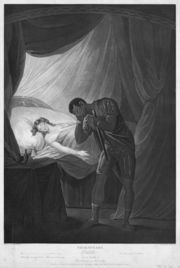
Iago now persuades Othello to be suspicious of Cassio and Desdemona. As it happens, Cassio is having a relationship of sorts with Bianca, a prostitute. Othello drops the handkerchief that was his first gift to Desdemona and which he has stated holds great significance to him in the context of their relationship. Iago asks Emilia to steal it. Emilia, unaware of what Iago plans to do with the handkerchief, steals it. Iago plants it in Cassio's lodgings as evidence of Cassio and Desdemona's affair. After he has planted the handkerchief, Iago tells Othello to stand apart and watch Cassio's reactions while Iago questions him about the handkerchief. Iago goads Cassio on to talk about his affair with Bianca, but very quietly mentions her name so that Othello believes they are still talking about Desdemona when Cassio is really speaking of Bianca. Bianca, on discovering the handkerchief, chastises Cassio, accusing him of giving her a second-hand gift which he received from another lover. Othello sees this, and Iago convinces him that Cassio received the handkerchief from Desdemona. Enraged and hurt, Othello resolves to kill his wife and Iago is "asked" to kill Cassio as a duty to their intimacy. Othello proceeds to make Desdemona's life a misery, hitting her in front of her family. Desdemona laments her suffering, remembering the fate of her mother's maid, who was forsaken by her lover.
Roderigo complains that he has received nothing for his efforts and threatens to abandon his pursuit of Desdemona, but Iago convinces him to kill Cassio instead, because Cassio has just been appointed in Othello's place, and -- Iago argues -- if Cassio lives to take office, Othello and Desdemona will leave Cyprus, thwarting Roderigo's plans to win Desdemona. Roderigo attacks Cassio in the street after Cassio leaves Bianca's lodgings. They fight and both are wounded. Cassio's leg is cut from behind by Iago who manages to hide his identity as perpetrator. Passers-by arrive to help; Iago joins them, pretending to help Cassio. Iago secretly stabs Roderigo to stop him from confessing, and accuses Bianca of conspiracy to kill Cassio.
In the night, Othello confronts Desdemona, and then kills her by smothering her in bed, before Emilia arrives. At Emilia's distress, Othello tries to explain himself, justifying his actions by accusing Desdemona of adultery. Emilia calls for help. The Governor arrives, with Iago and others, and Emilia begins to explain the situation. When Othello mentions the handkerchief as proof, Emilia realizes what Iago has done; she exposes him, whereupon Iago kills her. Othello, realizing Desdemona's innocence, attacks Iago but does not kill him, saying that he would rather have Iago live the rest of his life in pain. Lodovico, a Venetian nobleman, apprehends both Iago and Othello, but Othello commits suicide with a dagger before they can take him into custody. At the end, it can be assumed, Iago is taken off to be tortured and possibly executed.
Source
Othello is an adaptation of the Italian writer Cinthio's tale, "Un Capitano Moro" ("A Moorish Captain") from his Gli Hecatommithi (1565), a collection of one hundred tales in the style of Boccacio's Decameron.
No English translation of Cinthio was available in Shakespeare's lifetime, and verbal echoes in Othello are closer to the Italian original than to Gabriel Chappuy's 1584 French translation. Cinthio's tale may have been based on an actual incident occurring in Venice about 1508.[2] It also resembles an incident described in the earlier tale of "The Three Apples", one of the stories narrated in the One Thousand and One Nights (Arabian Nights).[3]
Desdemona is the only named character in Cinthio's tale, with his few other characters identified only as "the Moor" (Othello), "the squadron leader" (Cassio), "the ensign" (Iago), and "the ensign's wife" (Emilia). Cinthio drew a moral (which he placed in the mouth of Desdemona) that European women are unwise to marry the temperamental males of other nations.[4]
Cinthio's Moor is the model for Shakespeare's Othello, but some researchers believe the poet also took inspiration from the several Moorish delegations from Morocco to Elizabethan England circa 1600.[5]
While Shakespeare closely followed Cinthio's tale in composing Othello, he departed from it in some details. Brabantio, Roderigo, and several minor characters are not found in Cinthio, for example, and Shakespeare's Emilia takes part in the handkerchief mischief while her counterpart in Cinthio does not. Unlike in Othello, in Cinthio, Iago lusts after Desdemona and is spurred to revenge when she rejects him. Shakespeare's opening scenes are unique to his tragedy as is the tender scene between Emilia and Desdemona as the lady prepares for bed.
Shakespeare's most striking departure from Cinthio is the manner of his heroine's death. In Shakespeare, Othello suffocates Desdemona, but in Cinthio, Othello commissions Iago to bludgeon his wife to death with a sand-filled stocking. Cinthio describes each gruesome blow, and, when the lady is dead, Iago and Othello place her lifeless body upon her bed, smash her skull, and cause the cracked ceiling above the bed to collapse upon her, giving the impression its falling rafters caused her death.
In Cinthio, the two murderers escape detection. Othello then misses Desdemona greatly, and comes to loathe the sight of Iago. He demotes him, and refuses to have him in his company. Iago then seeks revenge by disclosing to Cassio Othello's involvement in Desdemona's death. The two depart Cyprus for Venice, and denounce Othello to the Venetian Seignory; he is arrested, taken to Venice, and tortured. He refuses to admit his guilt and is condemned to exile. Desdemona's relatives eventually find and kill him. Iago, however, continues to escape detection in Desdemona's death, but engages in other crimes while in Venice. He is arrested and dies after being tortured. Cinthio's "ensign's wife", Emilia, survives her husband's death to tell her story.[6]
Date and text
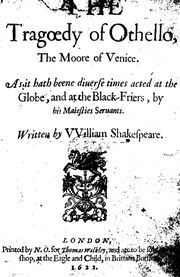
The earliest mention of the play is found in a 1604 Revels Office account, which records that on "Hallamas Day, being the first of Nouembar ... the Kings Maiesties plaiers" performed "A Play in the Banketinghouse att Whit Hall Called The Moor of Venis." The work is attributed to "Shaxberd." The Revels account was first printed by Peter Cunningham in 1842, and, while its authenticity was once challenged, is now regarded as genuine (as authenticated by A. E. Stamp in 1930).[7] Based on its style, the play is usually dated 1603 or 1604, but arguments have been made for dates as early as 1601 or 1602.[2][8]
The play was entered into the Register of the Stationers Company on October 6, 1621, by Thomas Walkley, and was first published in quarto format by him in 1622:
THE Tragœdy of Othello, The Moore of Venice. As it hath beene diuerse times acted at the Globe, and at the Black-Friers, by his Maiesties Seruants. Written by VVilliam Shakespeare. LONDON, Printed by N. O. [Nicholas Okes] for Thomas Walkley, and are to be sold at his shop, at the Eagle and Child, in Brittans Bursse, 1622.
One year later, the play was included among the plays in the First Folio of Shakespeare's collected plays. However, the version in the Folio is rather different in length, and in wording: as the editors of the Folger edition explain,
...the Folio play has about 160 lines that do not appear in the Quarto. Some of these cluster together in quite extensive passages. The Folio also lacks a scattering of about a dozen lines or part-lines that are to be found in the Quarto. These two versions also differ from each other in their readings of numerous words.[9]
Scholars differ in their explanation of these differences, and no consensus has emerged.[9] One explanation is that the Quarto may have been cut in the printing house to meet a fixed number of pages.[2] Another is that the Quarto is based on an early version of the play, while the Folio represents Shakespeare's revised version.[9] Most modern editions are based on the longer Folio version, but often incorporate Quarto readings of words when the Folio text appears to be in error.[10]
Quartos were also published in 1630, 1655, 1681, 1695, 1699 and 1705.
Themes and tropes
Othello's racial classification
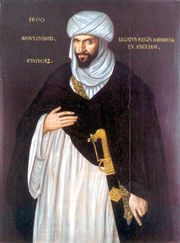
Othello is referred to as a "Moor", a term used during the English Renaissance to refer to dark-skinned people in general.[12] "Renaissance representations of the Moor were vague, varied, inconsistent, and contradictory. As critics have established, the term 'Moor' was used interchangeably with such similarly ambiguous terms as 'African', "Ethiopian', 'Negro', and even 'Indian' to designate a figure from different parts of Africa (or beyond) who was either black or Moslem, neither, or both."[13]
There is no consensus over Othello's racial classification, but the character is normally performed as a black person, although he was frequently performed as an Arab during the nineteenth century. In III.III Othello speaks of himself, saying "Haply for I am black" and later in III.III he denounces Desdemona's supposed sin as being "black as mine own face." Desdemona's physical whiteness is otherwise presented in opposition to Othello's dark skin; V.II "that whiter skin of hers than snow." Iago refers to their racial difference when in I.I he tells Brabantio that "an old black ram / is tupping your white ewe".
Michael Neill, editor of the Oxford Shakespeare edition, notes that the earliest external references to Othello's colour, (Thomas Rymer's 1693 critique of the play, and the 1709 engraving in Nicholas Rowe's edition of Shakespeare) assume him to be a black man, while the earliest known North African interpretation was not until Edmund Kean's production of 1814.[14] Modern-day readers and theatre directors normally lean towards the "black" interpretation, while North African Othellos are rare.[15]
Although the difference appears clear cut, E.A.J. Honigmann, the editor of the Arden Shakespeare edition, concluded that Othello's race is ambiguous. Various uses of the word 'black' (for example, "Haply for I am black") are insufficient evidence, Honigmann argues, since 'black' could simply mean 'swarthy' to Elizabethans.[16] Back then, French, British, and Italian people generally considered anyone who was "darker than snow white" with the term "black". Not just Sub-Saharan Africans were thus called, but anyone swarthy or Arab-looking. To many Europeans, the word "dark" and the word "black" were inter-changeable. Even some dark Caucasians were sometimes called "black."[17] So regarding the Moor Othello, the term "black" would not be conclusive proof necessarily for a Sub-Saharan typical "black" look for him in Shakespeare's mind.[18] Moreover, Iago twice uses the word 'Barbary' or 'Barbarian' to refer to Othello, seemingly referring to the Barbary coast inhabited by the "tawny" Moors. Roderigo calls Othello 'the thicklips', which seems to refer to European conceptions of Sub-Saharan African physiognomy, but Honigmann counters that, arguing that because these comments are all insults, they need not be taken literally.[19]
In addition, Honigmann questions whether the ambassador of the Arab King of Barbary, who stayed with his retinue in London in 1600 for several months and occasioned much discussion, might have inspired Shakespeare's play, written only a few years afterwards.[20]
Iago / Othello
Although eponymously titled, suggesting that the tragedy belongs primarily to Othello, Iago plays an important role in the plot, and has more lines than the title character. In Othello, it is Iago who manipulates all other characters at will, controlling their movements and trapping them in an intricate net of lies. He achieves this by getting close to all characters and playing on their weaknesses while they refer to him as "honest" Iago, thus furthering his control over the characters . A. C. Bradley — and more recently Harold Bloom — have been major advocates of this interpretation.[21]
Other critics, most notably in the later twentieth century (after F. R. Leavis), have focused on Othello. Apart from the common question of jealousy, some argue that his honour is his undoing, while others address the hints of instability in his person (in Act IV Scene I, for example, he falls 'into a trance').
Critical analysis
There have been many differing views on the character of Othello over the years. They span from describing Othello as a hero to describing him as an egotistical fool. A.C Bradley calls Othello the "most romantic of all of Shakespeare's heroes" and "the greatest poet of them all". On the other hand, F.R. Leavis describes Othello as "egotistical". There are those who also take a less critical approach to the character of Othello such as William Hazlitt saying that "the nature of the Moor is noble... but his blood is of the most inflammable kind".
Performance history
Othello possesses an unusually detailed performance record. The first certainly known performance occurred on November 1, 1604, at Whitehall Palace in London, being mentioned in a Revels account on "Hallamas Day, being the first of Nouembar", 1604, when "the Kings Maiesties plaiers" performed "A Play in the Banketinge house at Whit Hall Called The Moor of Venis." The play is there attributed to "Shaxberd".[22]
Subsequent performances took place on Monday, April 30, 1610 at the Globe Theatre, and at Oxford in September 1610.[23] On November 22, 1629, and on May 6, 1635, it played at the Blackfriars Theatre. Othello was also one of the twenty plays performed by the King's Men during the winter of 1612–13, in celebration of the wedding of Princess Elizabeth and Frederick V, Elector Palatine.
At the start of the Restoration era, on October 11, 1660, Samuel Pepys saw the play at the Cockpit Theatre. Nicholas Burt played the lead, with Charles Hart as Cassio; Walter Clun won fame for his Iago. Soon after, on December 8, 1660, Thomas Killigrew's new King's Company acted the play at their Vere Street theatre, with Margaret Hughes as Desdemona — probably the first time a professional actress appeared on a public stage in England.
It may be one index of the play's power that Othello was one of the very few Shakespearean plays that was never adapted and changed during the Restoration and the eighteenth century.[24] Famous nineteenth century Othellos included Edmund Kean, Edwin Forrest, Ira Aldridge, and Tommaso Salvini, and outstanding Iagos were Edwin Booth and Henry Irving.
The play has maintained its popularity into the 21st century. The most famous American production may be Margaret Webster's 1943 staging starring Paul Robeson as Othello and Jose Ferrer as Iago. This production was the first ever in the United States of America to feature a black actor playing Othello with an otherwise all-white cast (there had been all-black productions of the play before). It ran for 296 performances, almost twice as long as any other Shakespearean play ever produced on Broadway. Although it was never filmed, it was the first nearly complete performance of a Shakespeare play released on records. Robeson had first played the role in London in 1931 opposite a cast that included Peggy Ashcroft as Desdemona and Ralph Richardson as Roderigo, and would return to it in 1959 at Stratford on Avon.
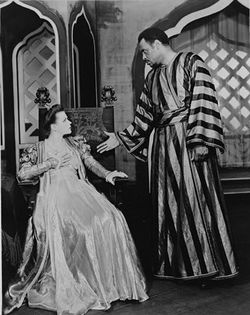
The American actor William Marshall performed the title role in at least six productions. His Othello was called by Harold Hobson of the London Sunday Times "the best Othello of our time,"[25] continuing:
"...nobler than Tearle, more martial than Gielgud, more poetic than Valk. From his first entry, slender and magnificently tall, framed in a high Byzantine arch, clad in white samite, mystic, wonderful, a figure of Arabian romance and grace, to his last plunging of the knife into his stomach, Mr Marshall rode without faltering the play's enormous rhetoric, and at the end the house rose to him."[26]
Marshall also played Othello in a jazz musical version, Catch My Soul, with Jerry Lee Lewis as Iago, in Los Angeles in 1968.[27] His Othello was captured on record in 1964 with Jay Robinson as Iago and on video in 1981 with Ron Moody as Iago.
Another famous production was the 1982 Broadway staging with James Earl Jones as Othello and Christopher Plummer as Iago, who became the only actor to receive a Tony Award nomination for a performance in the play.
When Laurence Olivier played his legendary and wildly acclaimed performance of Othello at the Royal National Theatre in 1964, he had developed a case of stage fright that was so profound that when he was alone onstage, Frank Finlay (who was playing Iago) would have to stand offstage where Olivier could see him to settle his nerves.[28] This performance was recorded complete on LP, and filmed by popular demand in 1965 (according to a biography of Olivier, tickets for the stage production were notoriously hard to get). The film version still holds the record for the most Oscar nominations for acting ever given to a Shakespeare film - Olivier, Finlay, Maggie Smith (as Desdemona) and Joyce Redman (as Emilia, Iago's wife) were all nominated for Academy Awards. Olivier was among the last white actors to be greatly acclaimed as Othello, although the role continued to be played by such performers as Paul Scofield at the Royal National Theatre in 1980, Anthony Hopkins in the BBC Shakespeare television production on videotape. (1981), and Michael Gambon in a stage production at Scarborough directed by Alan Ayckbourn in 1990.
When Sir Patrick Stewart played Othello at the Shakespeare Theater Company in Washington, D.C., he portrayed the Moor as a white man with the other characters played by black actors.
Actors have alternated the roles of Iago and Othello in productions to stir audience interest since the nineteenth century. Two of the most notable examples of this role swap were William Charles Macready and Samuel Phelps at Drury Lane (1837) and Richard Burton and John Neville at the Old Vic Theatre (1955). When Edwin Booth's tour of England in 1880 was not well attended, Henry Irving invited Booth to alternate the roles of Othello and Iago with him in London. The stunt renewed interest in Booth's tour. James O'Neill also alternated the roles of Othello and Iago with Booth, with the latter's complimentary appreciation of O'Neill's interpretation of the Moor being immortalized in O'Neill's son Eugene's play Long Day's Journey Into Night.
Othello opened at the Donmar Warehouse in London on 4 December 2007, directed by Michael Grandage, with Chiwetel Ejiofor as Othello, Ewan McGregor as Iago and Kelly Reilly as Desdemona. Despite tickets selling as high as £2000 on web-based vendors, only Ejiofor was praised by critics, winning the Laurence Olivier Award for his performance; with McGregor and Reilly's performances receiving largely negative notices. Stand up comedian Lenny Henry was the latest big name to play Othello. He did so on a tour at the start of 2009 produced by Northern Broadsides in collaboration with West Yorkshire Playhouse.[29]
Adaptations and cultural references
Opera
_par_F._Bouchot.jpg)
Otello, a three act opera with an Italian libretto by Francesco Maria Berio di Salsi and music by Gioachino Rossini was first performed at the Teatro del Fondo, Naples, on December 4, 1816. The opera deviates from Shakespeare's original in some aspects: Jago is less diabolical than his Shakespearean counterpart, the setting is Venice rather than Cyprus, and the composer and librettist provided an alternative happy ending to the work, a common practice with drama and opera at one time. The opera is rarely performed.
Giuseppe Verdi and librettist Arrigo Boito adapted Shakespeare's play to Otello, an Italian grand opera in four acts that was first performed at the Teatro alla Scala, Milan on February 5, 1887. It was Verdi's second to last opera (followed by another Shakespeare adaptation, Falstaff) and is considered by many to be Verdi's greatest opera. Verdi and his librettist dispensed with the first act of the play. The popular opera attracts world class singers and is found in the repertoire of prominent opera houses. Franco Zeffirelli's 1986 film version of Verdi's opera starring Plácido Domingo as Othello won the BAFTA for foreign language film.[30] (Indeed, according to the Kennedy Center's biographical note on Domingo, Laurence Olivier saw Domingo in Otello and, in a mockingly furious voice, told Franco Zeffirelli: "You realize that Domingo plays Othello as well as I do, and he has that voice!"[31])
On February 25, 1999, Bandanna, an English language opera in a prologue and two acts with a libretto by Irish poet Paul Muldoon and music by Daron Hagen was performed by the opera theater at The University of Texas in Austin. The opera is set in 1968 on the United States–Mexican border and borrows elements from Cinthio's tale, Shakespeare's play, and Verdi's opera.
Ballet

Mexican choreographer José Limón created a 20-minute, four character ballet called The Moor's Pavane to the music of Henry Purcell in 1949. The work premiered at the Connecticut College American Dance Festival in the same year. American Ballet Theatre was the first dance company outside Limon's to include the work in its repertory. It is a standard in dance companies around the world and notable interpreters of the Moor include Rudolf Nureyev.
The ballet Othello was choreographed by John Neumeier to music by Arvo Pärt, Alfred Schnittke, Naná Vasconcelos et al. and was premiered by the Hamburg Ballet in Hamburg on January 27, 1985, with Gamal Gouda as Othello, Gigi Hyatt as Desdemona, and Max Midinet as Iago. The work remains in the repertoire of the Hamburg Ballet, seeing its 100th performance in 2008.
In 2002, modern dance choreographer Lar Lubovitch created a full-length ballet in three acts based on the Shakespeare play and Cinthio's tale with a score by Elliot Goldenthal. The work has been staged by the San Francisco Ballet with Desmond Richardson, Yuan Yuan Tan, and Parrish Maynard in the principal roles. The ballet was broadcast on PBS's Great Performances: Dance in America and the program was nominated for an Emmy Award. The ballet is recorded on Kultur video. Othello was first performed in New York City at the Metropolitan Opera House, May 23, 1997, by American Ballet Theatre.[32]
Other ballets include Prologue choreographed by Jacques d'Amboise for the New York City Ballet in 1967 as a prequel to Shakespeare's play, Othello choreographed by John Butler to the music of Dvořák for Carla Fracci and the La Scala Ballet in 1976, and a version choreographed by Jean-Pierre Bonnefous for the Louisville Ballet in the 1980s.
Film
- See also Shakespeare on screen (Othello).
Two fine Italian silent versions of Othello were shot on location in Venice in 1909 and 1914 respectively (Buchanan, Shakespeare on Silent Film (2009)). A further two silent screen adaptations of Othello (1909 and 1922) emerged from the German film industry. The 1909 version was directed by, and stars, Franz Porten as Othello, Henny Porten as Desdemona, and Rosa Porten as Emilia. The 1922 film stars the celebrated Emil Jannings as Othello, Werner Krauss as Iago, and Ica von Lenkeffy as Desdemona (Buchanan, Shakespeare on Silent Film (2009)).[33]
A production of "Othello" forms the backdrop for "A Double Life," starring Ronald Colman as an actor who takes on the personality traits of whatever character he happens to play.
The Orson Welles-directed 1952 version, The Tragedy of Othello: The Moor of Venice was also filmed in black and white.[34] The film stars Welles as Othello and Suzanne Cloutier as Desdemona. The troubled production was filmed over the course of three years as Welles' time and money permitted. Lack of funds (and costumes) forced Roderigo's death scene to be shot in a Turkish bath with performers wearing only large, ragged towels. The film won the Palme D'Or at the 1952 Cannes Film Festival.
- Othello (1955), USSR, starring Sergei Bondarchuk, Irina Skobtseva, Andrei Popov. Directed by Sergei Yutkevich.[35]
- All Night Long (1962) A British adaptation in which the character of Othello is Rex, a jazz bandleader. Featuring Dave Brubeck and other modern jazz musicians.[36]
- Othello (1965) starring Laurence Olivier, Maggie Smith, Frank Finlay, and Joyce Redman[37]
- Catch My Soul (1974) adapted from Jack Good's rock musical, directed by Patrick McGoohan and starring Richie Havens, Lance LeGault, Season Hubley and Tony Joe White.[38]

- Othello, the Black Commando was a 1982 update of the film written by and starring Max H. Boulois with Tony Curits as Colonel Iago and Joanna Pettet as Desdemona[39]
- Othello (1995) starring Kenneth Branagh, Laurence Fishburne, and Irene Jacob. Directed by Oliver Parker.[40]
- Kaliyattam (1997), in Malayalam, a modern update, set in Kerala, starring Suresh Gopi as Othello,which won him the national award for best actor, Lal as Iago, Manju Warrier as Desdemona, directed by Jayaraaj.[41]
- O (2001) a modern update, set in an American high school. Stars Mekhi Phifer, Julia Stiles, and Josh Hartnett[42]
- Omkara (2006) (Hindi) is an Indian version of the play, set in the state of Uttar Pradesh. The film stars Ajay Devgan as Omkara (Othello), Saif Ali Khan as Langda Tyagi (Iago), Kareena Kapoor as Dolly (Desdemona), Vivek Oberoi as Kesu (Cassio), Bipasha Basu as Billo (Bianca) and Konkona Sen Sharma as Indu (Emilia). The film is directed by Vishal Bharadwaj who earlier adapted Shakespeare's Macbeth as Maqbool. All characters in the film share the same letter or sound in their first name as in the original Shakespeare classic. It is one of the few mainstream Indian movies to contain uncensored swear-words.
- Eloise (2002) a modern update, set in Sydney, NSW, Australia.
- Jarum Halus (2008) a modern Malaysian film, in English and Malay by Mark Tan.[43]
Television
- Othello (1981), actually shot on videotape, part of the BBC's complete works of William Shakespeare on television. Starring Anthony Hopkins and Bob Hoskins.[44]
- Othello (1990) A film version of the last Royal Shakespeare Company production at The Other Place in 1989 starring Michael Grandage, Ian McKellen, Clive Swift, Willard White, Sean Baker, and Imogen Stubbs. Directed by Trevor Nunn.
- Othello (2001). British made-for-TV film. A modern-day adaptation in modern English, in which Othello is the first black Commissioner of London's Metropolitan Police. Made for ITV by LWT. Scripted by Andrew Davies. Directed by Geoffrey Sax. Starring Eamonn Walker, Christopher Eccleston and Keeley Hawes.[45]
Graphic novels
Othello, an adaptation by Oscar Zarate, Oval Projects Ltd (1985). It was reprinted in 2005 by Can of Worms Press and includes the complete text of the play.
Gallery
 First Folio (1623) title page facsimile |
 A Bedchamber, Desdemona in Bed asleep, published by John and Josiah Boydell (1803) |
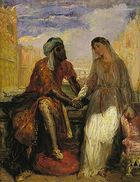 Othello and Desdemona in Venice by Théodore Chassériau (1819–1856) |
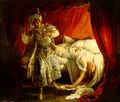 Othello and Desdemona by Alexandre-Marie Colin, 1829 |
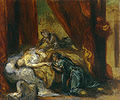 The Death of Desdemona by Eugène Delacroix |
 Edwin Booth as Iago, ca. 1870 |
 Italian actor Tommaso Salvini as Othello, 1875 |
 American actor John McCullough as Othello, 1878 |
 Othello relating his adventures to Desdemona and Brabantio from a steel engraving of a painting by Charles West Cope, 1873 |
Desdemona's Death Song by Dante Gabriel Rossetti, ca. 1878-1881 |
Thomas Keene in Othello, 1884 |
 Desdemona by Frederic Leighton, ca. 1888 |
References
- ↑ Oxford School Shakespeare - Othello
- ↑ 2.0 2.1 2.2 Shakespeare, William. Four Tragedies: Hamlet, Othello, King Lear, Macbeth. Bantam Books, 1988.
- ↑ Young, John G., M.D.. "Essay: What Is Creativity?". Adventures in Creativity: Multimedia Magazine 1 (2). http://www.adventuresincreativity.net/2mag1.html. Retrieved 2008-10-17.
- ↑ Virgil.org
- ↑ Professor Nabil Matar (April 2004), Shakespeare and the Elizabethan Stage Moor, Sam Wanamaker Fellowship Lecture, Shakespeare's Globe Theatre (cf. Mayor of London (2006), Muslims in London, pp. 14-15, Greater London Authority)
- ↑ Bevington, David and Kate Bevington, translators. "Un Capitano Moro" in Four Tragedies: Hamlet, Othello, King Lear, Macbeth. Bantam Books, 1988. pp. 371-387.
- ↑ Sanders, Norman (ed.). Othello (2003, rev. ed.), New Cambridge Shakespeare, p. 1.
- ↑ Honigmann (ed), Othello (1997), Arden Shakespeare, Appendix 1, pp 344-350.
- ↑ 9.0 9.1 9.2 Paul Westine and Barbara Mowat, eds. Othello, Folger Shakespeare Library edition (New York: WSP, 1993), p.xlv.
- ↑ Paul Westine and Barbara Mowat, eds. Othello, Folger Shakespeare Library edition (New York: WSP, 1993), pp.xlv-xlvi.
- ↑ Vaughan, p.59
- ↑ "Moor, n2", The Oxford English Dictionary, 2nd edtn.
- ↑ Making More of the Moor: Aaron, Othello, and Renaissance Refashionings of Race. Emily C. Bartels
- ↑ Michael Neill, ed. Othello (Oxford University Press), 2006, p. 45-7.
- ↑ Honigmann, 17.
- ↑ Oxford English Dictionary, 'Black', 1c.
- ↑ Who Were/Are The Moors??? - BlackWebPortal
- ↑ Who's black and whose black? - AmoebaBlog
- ↑ E.A.J. Honigmann, ed. Othello. London: Thomas Nelson, 1997, p. 15.
- ↑ Honigmann, 2-3.
- ↑ Shakespeare, William; Ruffiel, Burton (2005) [Oct. 3]. Othello (Yale Shakespeare). Bloom, Harold. Yale University Press.
- ↑ Shakespeare, William. Four Tragedies. Bantam Books, 1988.
- ↑ Loomis, Catherine ed. (2002). William Shakespeare: A Documentary Volume, Vol. 263, Dictionary of Literary Biography, Detroit: Gale, 200-1.
- ↑ F. E. Halliday, A Shakespeare Companion 1564-1964, Baltimore, Penguin, 1964; pp. 346-47.
- ↑ Jet magazine, 30 June 2003
- ↑ The (London) Independent, 6 July 2003
- ↑ Christgau, Robert. Any Old Way You Choose It, ISBN 0815410417
- ↑ Laurence Olivier, Confessions of an Actor, Simon and Shuster (1982) p. 262
- ↑ "Shakespeare’s Othello | Cast & Creative - Lenny Henry". Othellowestend.com. 2002-11-11. http://www.othellowestend.com/cast_and_creative/cast/lenny_henry/. Retrieved 2009-11-01.
- ↑ Otello (1986)
- ↑ "Biographical information for Placido Domingo". Kennedy Center. http://www.kennedy-center.org/calendar/index.cfm?fuseaction=showIndividual&entitY_id=3525&source_type=A. Retrieved 2009-11-01.
- ↑ "Great Performances . Dance in America: Lar Lubovitch's "Othello" from San Francisco Ballet | PBS". PBS. http://www.pbs.org/wnet/gperf/shows/othello/othello.html. Retrieved 2009-11-01.
- ↑ Othello (1922)
- ↑ The Tragedy of Othello: The Moor of Venice (1952)
- ↑ See Отелло at the Internet Movie Database
- ↑ All Night Long (1962)
- ↑ Othello (1965)
- ↑ "Catch My Soul (1974)". http://www.imdb.com/title/tt0071289/.
- ↑ IMDb.com
- ↑ Othello (1995)
- ↑ Kaliyattam (1997)
- ↑ O (2001)
- ↑ Jarum Halus official website
- ↑ Othello (1981) (TV)
- ↑ Othello (2001) (TV)
External links
- Othello Navigator—Includes the annotated text, a search engine, and scene summaries.
- Cinthio's Tale—A Nineteenth Century English translation of Shakespeare's primary source.
- Othello—text by PublicLiterature.org
- Othello—Scene-indexed and searchable version of the text.
- Othello at IBDB—lists numerous productions.
- Othello study guide, themes, quotes, multimedia, and teacher resources
|
|||||||||||||||||||
|
||||||||||||||||||||||||||||||